Humpback whale season started early for me this year.
Instead of heading south in August like I normally do however, I went north in July to Alaska, where I had an opportunity to witness and photograph one of the most extraordinary spectacles in the natural world...humpback whales engaged in cooperative bubble net feeding, also known as social foraging.
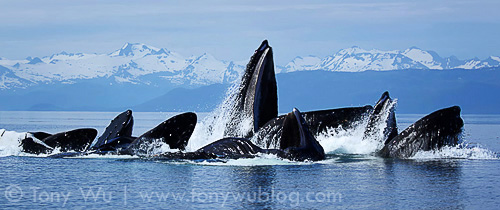
Humpback whales bubble net feeding in Alaska
Planning for this trip started many moons ago, back in March or so 2011, when I had a brain splat during a Skype conversation with my friend Jon Cornforth.
We were chatting about possibilities for working together, and it occurred to me that between us, we had extensive experience and success documenting just about every well-known aspect of humpback whale behaviour.
Jon had spent several seasons tooling around the waters near Juneau, Alaska following and photographing the movements of humpback whales during their feeding season in that area.
Meanwhile, I had spent ten seasons in Tonga photographing the other half of humpback whale life...competing for mates, engaging in courtship, having and raising babies, etc.
As luck would have it, the humpback whale seasons in Alaska and Tonga dovetail nicely, so it seemed logical to combine the two destinations into one grand adventure...an ambitious trip in which our fellow travellers would have the unique opportunity to see a broad range of humpback whale activity...a dual-hemisphere humpback extravaganza that we dubbed Megaptera Mania!
Following are a few highlights from the first part of our Megaptera Mania! trip in Alaska, which, as I’m sure you’ll see, was an unequivocal success.
Humpback Whale Bubble Net Feeding
Picture yourself floating in a small dinghy with a few friends. It’s sunny, with a gentle, almost imperceptible breeze that’s cool, but warmer than you'd expected. Snow-capped mountains line the horizon. A bevy of boats populated with eager fishermen and women pass by, casting lines in hopes of landing salmon, herring, halibut, possibly other tasty fish.
It’s a picture-perfect summer day in Alaska. Conditions are just right to doze off. But you don’t want to.
Because somewhere below, humpback whales are on the prowl.
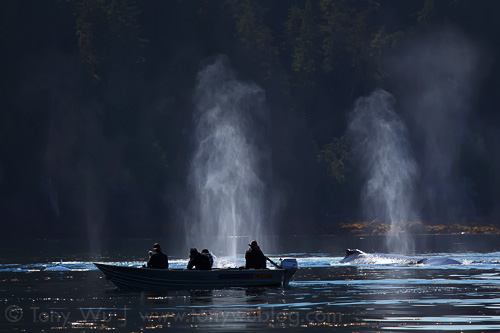
Humpback whales resting between bubble net feeding sessions
During the northern hemisphere summer, humpback whales travel from warmer climates to higher latitudes like the waters around Alaska for exactly the same reason that many people do...to catch tasty fish.
Here’s where it gets interesting...some of the whales that visit Alaska engage in a fascinating cooperative foraging technique called bubble net feeding. In essence, a number of whales join forces and work together to corral fish (primarily herring I think) and herd them to the surface. They do this by using a choreographed combination of sound and air bubbles.
It’s one thing to describe this tag-team technique in words, but there’s really no adequate way of conveying in writing the sensation of seeing (and feeling) hundreds of tonnes of cetacean-mass explode through the water’s surface, sending scores of freaked-out fish flying frantically through the air. It’s just kick-b*** awesome.

Humpback whales with mouths wide open.
See the helpless herring flying through the air?
Hearing some audio of the coordinated attack strategy might help to transport you to the scene though.
Close your eyes and listen to what an attack squadron of humpback whales sounds like...from a fear-filled fish’s point of view:
[audio src="http://www.tonywublog.com/wp-content/uploads/2012/08/humpback-whale-bubble-net-feeding-alaska-1.mp3"](Note: At 53 seconds, you can hear to splash of the whales breaking the surface of the ocean, swallowing heaps of horrified herring in the process)
One thing we noticed is that there was variation in the sounds that the whales make, both among different groups of humpbacks, and also among different attacks coordinated by a given group of whales. In addition, one group of whales we came across made nearly no sounds, appearing to round-up prey primarily with bubbles.
Given that this was my virgin experience with bubble net feeding, I'm not certain whether this has any significance.
I also don't know whether the different groups we encountered comprised the same whales, entirely different whales, or a mixture of both.
We did see a number of whales that left feeding groups, as well as other whales that joined the groups throughout the day. We also recognised a few whales across multiple encounters, so overall, it seemed as if the size and composition of the bubble net feeding groups were somewhat malleable.
The largest number of whales we counted in a given group was 15 individuals, plus a calf that wasn’t involved in the bubble net feeding. The calf’s mother was among the whales in the foraging group.
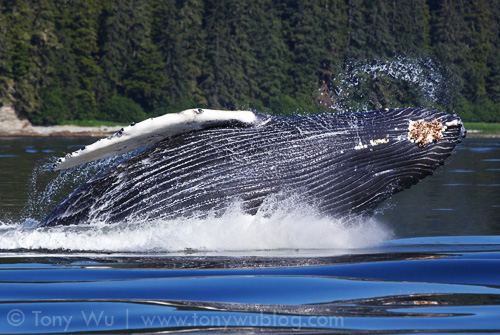
Humpback whale calf playing. Mommy was part of a bubble net feeding group.
Anyway, here’s another audio sample. Compare this to the audio above, and you’ll hear that the sounds are quite different in places. Note in particular the “Tarzan” sound after the 40-second mark, and the odd baby-burping sounds that come in from time to time. All very cool.
[audio src="http://www.tonywublog.com/wp-content/uploads/2012/08/humpback-whale-bubble-net-feeding-alaska-2.mp3"]
One final audio snippet, which I personally find to be the most interesting. Listen to the clip below and see if you can think like a humpback whale and figure out what happened. It’s extremely different from the two sound segments above.
(Warning: The humpbacks overwhelmed our poor little hydrophone in a few spots, so the audio cracks a bit. Turn the volume down if you’re listening with headphones, so it doesn’t hurt your ears.)
[audio src="http://www.tonywublog.com/wp-content/uploads/2012/08/humpback-whale-bubble-net-feeding-alaska-3.mp3"]
Pinnipedia
I love pinnipeds. They’re generally cute, playful, inquisitive...and often comical to boot.
During our stay in Alaska, we came across two species of pinnipeds...Steller sea lions (Eumetopias jubatus) and harbor seals (Phoca vitulina).
The Stellers were a noisy lot, barking at each other constantly, making an enormous racket that could be heard from a long distance. They also smelled. Bad. As in...it wasn’t pleasant being downwind of them. Or upwind, for that matter.
But hey...what they lacked in personal hygiene, they made up for in entertainment value.
For example, here are some sea lions occupying prime waterfront real estate:
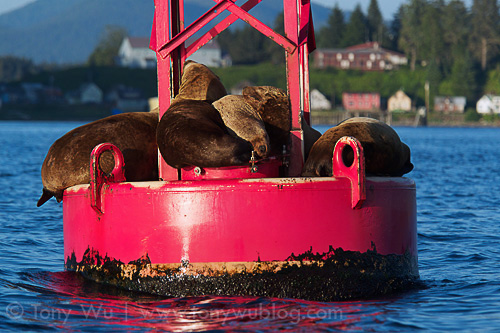
Steller sea lions chilling out in the evening
As is the case with exclusive residential estates the world over, space was at a premium. Quite naturally, the established residents were inclined to safeguard their posh premises with considerable vigour.
In this instance, along came a big-bottomed bully sea lion, who, in a clear breach of pinniped etiquette, attempted to expropriate a portion of said waterfront property for himself, much to the consternation of the existing tenants.
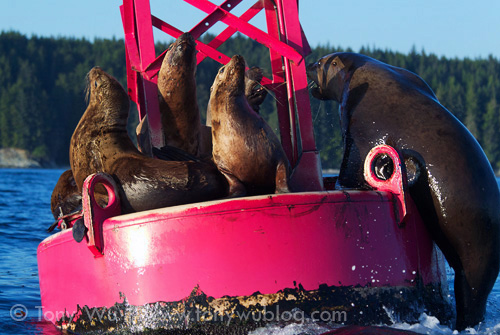
Steller sea lion interloper disturbing the peace
A few barks, nips and shoves later, the big bully with the big butt ended up right back in the water where he belonged.
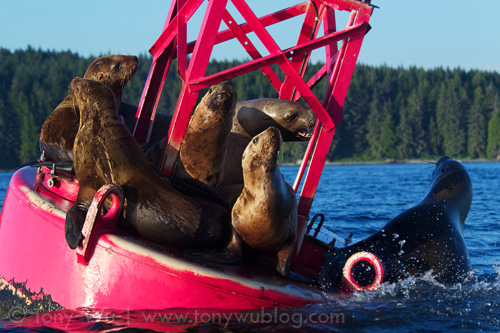
Bottom-heavy Steller sea lion falling back into the water
I’m sure there’s a profound moral in there somewhere, but I’m far too jet-lagged to work it out.
As for the harbor seals, I think the best way to convey how cute 'n cuddly they appeared is with a few photos:

Adorable harbor seal
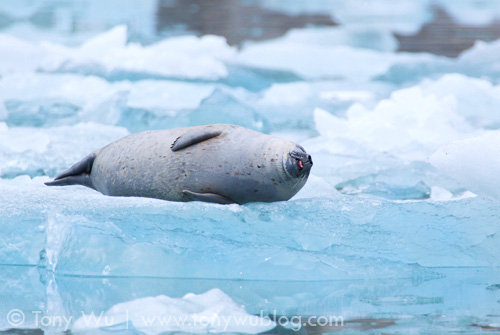
Harbor seal sticking its tongue out while asleep
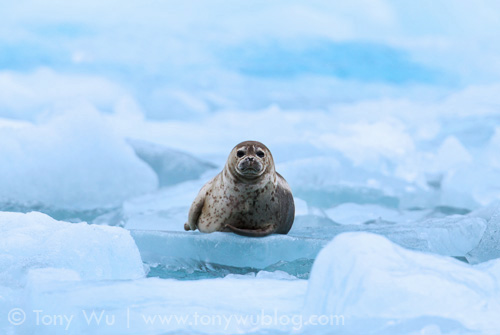
Harbor seal perfectly perched on ice
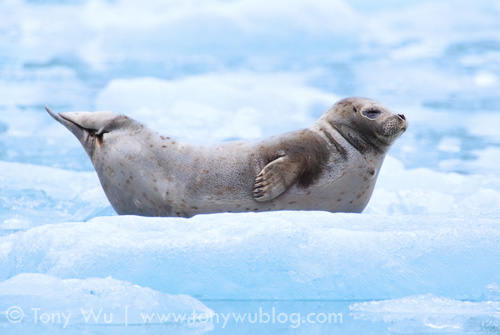
Harbor seal sleeping on iceberg. How cute is this?!
Figured it Out?
Did you figure out what happened in the third audio clip above?
If you didn’t (or didn’t listen to it) go back and listen again. Pay attention to the abrupt change at the 38-second mark.
The sounds morph from high-pitched hunting tones to a serious of gurgles, grunts and general pandemonium.
If it sounds like a bunch of whales hurling obscenities at one another, that’s because it might be. Not literally of course, but in this particular instance, it appeared as if the whales had to abort their hunt mid-bubble-curtain. We didn’t see them execute the bubble net manoeuvre, and after a while, they surfaced some distance away to take a series of breaths, then dive down to try again.
Who knew that humpbacks had such tempers?!

Humpback whales giving some fishermen a surprise
Wrap Up
I’m experiencing discombobulated desynchronosis (severe jet lag), so I'm going to wrap this up.
I’m departing this week for the southern hemisphere part of our Megaptera Mania! trip...which means total and utter chaos for the next few days. What else is new?
Just a quick note to clarify that the humpback whales we’ll see down south are a separate population from the ones we saw in Alaska. The whales in the northern hemisphere and southern hemisphere run on opposite cycles, since the seasons are diametrically opposed. It’s summer in Alaska (feeding time) and winter in Tonga (breeding/ calving time).
So technically, we’re not seeing the entire lifecycle of a single population of humpback whales. We are crossing the equator to see two different populations of whales at two different stages in their annual lifecycles.
I wish it were possible to follow a single population through the entire year, but the logistics and costs that would entail boggle the imagination!
To conclude, I’d like to thank Jon for making Megaptera Mania! Alaska a success, as well as to acknowledge our fellow travellers...Colin, Nana, Julian, Ildi, Bryn and Bert...for being awesome.
And finally, I’d like to thank Captain Phil (aka Papa Smurf) and Mary for taking such great care of us, and for putting up with our very early mornings and late evenings.
Tonga...here we come!
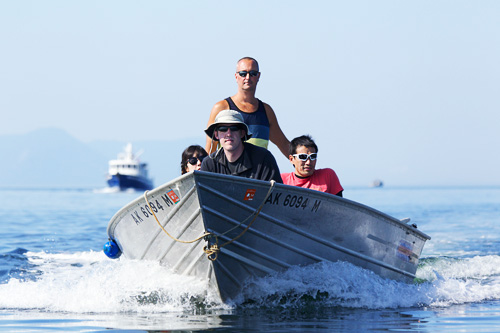
We had one day with absolutely perfect weather...and whales too!
PS: Jon enjoyed my company so much that we're considering running the trip again in the future. Let me know if you're interested: My contact form.